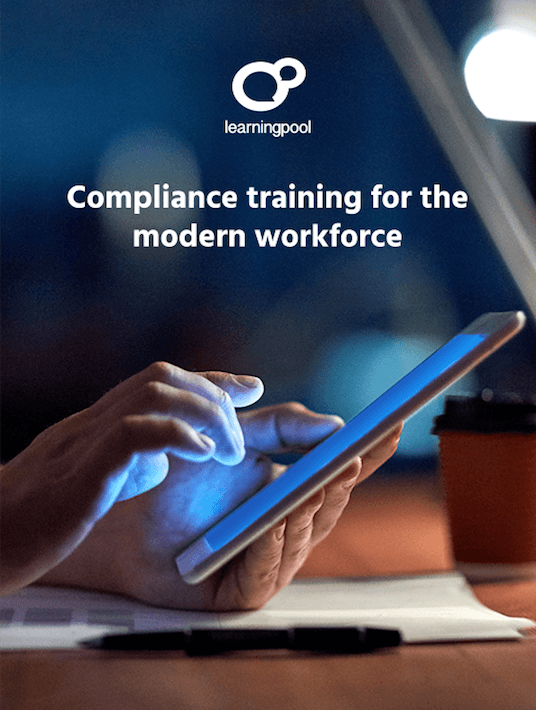Compliance Training Catalogues: How To Create A Gamified eLearning Experience
But let’s hold that thought for a moment. We know that kids learn very effectively through games, so why shouldn’t adults? We also know that the gaming industry now occupies a large space in modern life. It’s not surprising then that eLearning providers are now looking towards gamification of learning not only to make their products more attractive but also, more critically, to use the experience and mechanics of games to make learning more attractive and engaging and aid the retention and application of knowledge.

What Is Gamification?
Gamification describes the use of the mechanics and thinking that are behind games. It’s designed to present learning as a challenge to learners, to motivate them to acquire knowledge. You proceed through the learning content in a way in which you might play a game, moving onwards and upwards to the next level of attainment and expertise. Games promote learning by doing, presenting the modern learner with tasks to complete, and making acquiring knowledge a challenge or quest. And just like in any good game, there are risks and rewards that depend on how you play.
What’s Involved?
Let’s look in more detail at the key features of gamified learning:
The Goal
Firstly, like with all games, there’s the challenge. Learners are given a task to complete or a goal to reach. As they progress through the game, learners uncover information in their quest for knowledge. Certain information may be withheld until the appropriate moment, endowing it with greater impact and sustaining the learner’s interest.
Ready, Steady, Go
All games have a start point and learners have the choice of determining when to start and when to pause or stop. Gamification allows learners to proceed at their own pace. Some may race ahead, while others will take more time to explore. This self-paced aspect caters to individual preferences and is more effective than Instructor-Led Training that fires large amounts of information at learners regardless of their needs and potential to absorb it. You may still want to stimulate learners to complete the training within a certain time-frame, so some game-based learning may be against the clock.
The Game Environment
Gamified eLearning makes use of all the multimedia aspects we associate with online games. The rich visuals, audio, and video stimulate learners and give greater impact to the learning. Making content interactive encourages learners to progress through the game and pick up information on the way.
Feedback
As modern learners engage with the game, they receive feedback in the form of new information or simply encouragement to proceed. Feedback can bring out the context and reasoning behind the content.
Score
Scoring lets learners know immediately how they’ve done in activity. Points can be aggregated to reflect achievement. A run of success (correctly answering a certain number of questions in a row, for example) can lead to a bonus that might be ‘cashed in’ later.
Levels
We’re always talking about the need to take things to the next level. Gamification uses different levels to recognise the degree of difficulty of the material and motivate learners. Learners who already have expertise in an area can also demonstrate their prior knowledge by moving swiftly to the next level or even skipping a level.
Dashboards And Leaderboards
As learners accrue points, they can check their own progress and completion on a dashboard. The dashboard also displays what’s left to complete, and how much time is left to complete it. This can be private to the individual learner, but if you want to introduce a sense of competition, results can be displayed on a leaderboard, so learners see how they rank. This competitive element acts as a further stimulus to learn and reach the end goal.
Badges
Badges can be awarded for attainment within the game and beyond. Employees who receive badges from eLearning can have them recognised in their employment record and be rewarded accordingly. The game potentially offers a material reward.
Games Are Not Trivial
Engagement is the first step, but the true goal of any training is the results. Learners will need to see the relevance of any eLearning game: it needs to be more than just a bit of fun. Learners are more likely to retain information if they see its relevance—as something they genuinely need.
In fact, games can help learners make the vital link between the knowledge they’re acquiring and how it needs to be applied. Credible, contextualised game-based scenarios show how and why the information presented matters. A game-based approach to learning can provide an answer to the overriding question and biggest motivational pull: what’s in it for me?
Getting More From The Game
The results you achieve in playing an online game are generally transitory and immaterial. They can certainly give you a sense of achievement, but it’s confined to the game environment. The game is the beginning and the end: it says you’re good at the game, but not necessarily anything more.
But if you marry the gaming approach to learning, the rewards can be of a different order. Results carry over outside of the game as learners apply what they’ve learned in their work. Learners can use their achievements in the eLearning game to be rewarded in the working environment. Points can mean real, tangible prizes.
Compliance As A Game
Making learning fun is a way of engaging learners. And disengagement, lack of motivation and an inability to understand why training matters are all features that have bedeviled compliance. Making a game of compliance could be the way forward.
The gaming approach has a special resonance with compliance training. Games are rule-based, and compliance is above a series of rules and regulations. Games demonstrate how those rules need to be applied and the risks involved in not following the rules.
But they do so in a fail-safe environment, so learners can explore the potential costs of not playing by the rules without suffering the true consequences. The knowledge of the boundaries and the nuances involved in remaining compliant help alter behaviour and instill in employees a sense of how to behave when faced with real challenges at work.
Why Learning Pool Is A Player
Learning Pool compliance training catalogues, quality-assured by the Institute of Leadership and Management, include a gamification layer in their eLearning modules. This means you get the benefit of a gamified learning experience without needing to hire games developers to develop your own.
Learning Pool’s Adapt Builder has all the elements needed to provide gamification for your compliance training including:
- An Avatar that guides you through the content and provides feedback at critical points.
- Badges that provide rewards for as they solve puzzles and a gateway to further learning as they pick up badges.
- A Health Gauge that reflects learners’ performance in how they’ve answered questions just like a health bar in a video game.
- Intro videos that introduce learners to a module and sets the scene for what’s ahead.
- Outro videos that present information to learners on completion of the module based on their progression.
- Learning Objectives that are associated with eLearning components and used in conjunction with assisted learning and badges.
- Assisted Learning that means that once learners have completed an assessment they are guided back through the content associated any learning objectives they’ve failed and to attempt any failed questions again.
- A Mentor that offers learners hints, tips, feedback on questions and additional information.
- The Mission Menu that provides navigation through each course as part of the game’s visual metaphor.
- A Schedule Menu that sets timelines for completion.
Compliance training, from Learning Pool, employs game-based thinking, mechanics, and aesthetics to engage and motivate learners, to grab attention and increase knowledge retention. Every module is a different game.
Learning Pool uses gamification to make training memorable and change behaviours. Games place learners in control and to adopt responsibility for their learning. Gamified eLearning recognises what employees already know and sets them the challenge to improve their knowledge and skills.
Gamification squares up to the biggest challenges of all in compliance training: lack of motivation, disengagement, and a sense of irrelevance. Check out Learning Pool’s compliance training catalogues to see how gamified eLearning can make a difference to your organisation.
Sources:
- 7 creative ways to incorporate storytelling in compliance online training
- Getting to grips with gamification. - five top tips for beginners
- Case Study - Creating Highly Engaging Corporate Compliance Training With Gamification
- Kill The Boredom Of Compliance Training With Gamification
- 8 Tips To Use Compliance Online Training Gamification To Collect Feedback
- Game-Based Compliance: How Game-Based Learning Enlivens Monotonous Compliance Training







